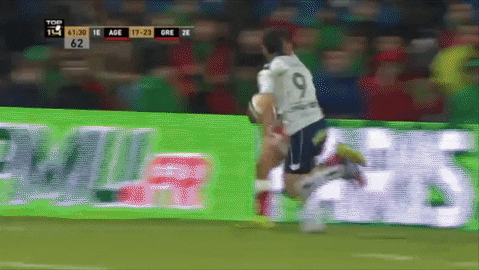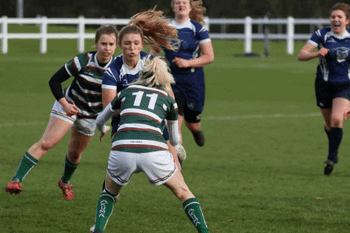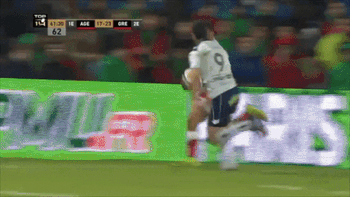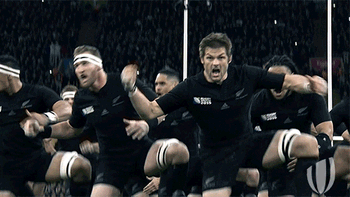Rugby FAQs

What’s the difference between rugby union and rugby league?
Rugby union and rugby league are like the Hadid sisters, same-same but different. Rugby union is the real OG, as rugby league is a faster-paced game developed from the original rules of rugby union. This is why rugby union is usually referred to as ‘rugby’ and rugby league is never referred to as ‘rugby’ but often referred to as ‘league’.
Rugby and league have the same aim of the game: get the ball to the opposite end of the field for a try or goal to gain points BUT to show you how they differ, here’s a v. cool chart:

I’ve heard of the New Zealand All Blacks, but what pro rugby teams are there in Canada?
Like the All Blacks (New Zealand’s national rugby team that is known for their infamous ‘Haka’), Canada has several teams that are part of World Rugby. Rugby Canada has both men’s and women’s teams and, yes; there is full contact in women’s professional rugby.
Rugby Canada also has both men’s and women’s sevens teams. Sevens is another form of rugby derived, again, from the real OG rugby (union). To keep it simple, sevens is a stripped-down version of rugby with the main difference being the number of players on the pitch. Rugby has 15 players on the pitch (reminder: league has 13) and sevens has, well, obviously seven.
By now, you Canadians may have hopped onto the Toronto Wolfpack bandwagon. If you haven’t, why TF not? The Wolfpack became the first league team in Canada when they were inaugurated into the British Rugby Football League in 2016. Yeah, baby! Yeah!
Since they have a rugby league team in the GTA, they obviously had to get a rugby union one! And they say you can’t have your cake and eat it too… Pfft! The Toronto Arrows joined the Major League Rugby (MLR) in 2019 and are the only Canadian team.
Rugby (Union)
- Players: 15 players on the field
- Tackles: Infinite number of tackles. Play just keeps going until one team loses possession or the opposition steals the ball.
- Points: Try = 5 points; Drop Goal = 3 points; Conversion = 2 points
- Rucks: When a player gets tackled and ‘goes to ground’, they need to try to get the ball backwards to their players standing behind them. The other team is trying to come in over the top to steal the ball- this is usually when ‘rucks’ form.
- Scrums: Union has contested scrums (players actually push against the other team’s scrum to try to gain possession of the ball). Scrums happen to restart the game after a minor infringement of the rules.
- Popularity: Played internationally in many countries. Top teams in World Rugby are New Zealand, Ireland, and Wales.
- Major Leagues: Super Rugby (Argentina, Australia, New Zealand, South Africa & Japan), Premiership Rugby (England), RFU Championship(England); Major League Rugby (USA & Canada)
League
- Players: 13 players on the field
- Tackles: Finite number of six tackles before the team has to ‘turnover’ the ball – give it to the other team.
- Points: Try = 4 points; Goal = 2 points; Drop Goal = 1 point
- Rucks: Don’t exist in league- they just have a ‘play the ball’ where, once a player is tackled, they get up and roll the ball through their legs with their foot and the other team can’t try to steal it.
- Scrums: League has uncontested scrums as the ball is fed to the second row and has little chance for the hooker to try and steal it. Basically, there’s no point to it other than to restart the game after accidental infringement.
- Popularity: League is popular in the UK, Australia, and New Zealand and has only recently expanded to a few other countries like Canada.
- Major Leagues: Super League (England & France), Betfred Championship & League 1 (UK, Wales, France, Canada), National Conference League (England); National Rugby League (Australia)
Do rugby players really not wear protective padding or equipment?
Who wears short-shorts? Rugby players do! But besides the shorts, jersey, mouthguard, cleats and socks, rugby players do not wear any protective padding or equipment which is v. different from the other contact sports we’re used to seeing (hockey, football, lacrosse, etc.). However, rugby has certain laws such as high tackles and neck contact (Law 10.4), challenging players in the air (Law 10.4), and scrum feed (Law 20.6) that players must abide by to help avoid serious injuries to themselves and other players. Grab my Chihuahua; I’m ready for Harvard Law now.
Wait - concussions are a pretty deal in sports right now, why don’t rugby players at least wear helmets to prevent them?
Some rugby players wear scrum caps that can provide additional protection from cuts and head injuries but, TBH, it has nothing to do with preventing concussions. The scrum cap is a fashion faux pas very thin layer of padding; it was created to prevent cauliflower ears. Wearing head gear any larger than a scrum cap wouldn’t exactly work for this game as it would be impossible for the players to bind in the scrum.
Which sport is rougher: rugby or football?
Depends if you ask the player on the pitch or the one on the field but, I mean, the fact that rugby has a ‘blood bin’ could probably answer this question…
Does rugby have a Super Bowl like football?
No, not exactly. Rugby union has a Rugby World Cup for both men and women (and even recently dropped any gender markings for the tournaments in a landmark push for equality) which are international championships that are formatted similar to the FIFA World Cup. Teams from countries have to qualify to compete.
Rugby also has the prominent Six Nations Championship (aka the Guinness Six Nations) which is an annual international rugby union competition between England, France, Ireland, Italy, Scotland and Wales. Since we weren’t invited to the Six Nations, we said ‘f*ck ‘em’ and started our own thing called the Americas Rugby Championship (we even sometimes call it the ‘Americas Six Nations’), a competition that hosts Argentina, Brazil, Canada, Chile, the US and Uruguay.
Enjoying this article? Want more?

Sign up for The GIST and receive the latest sports news straight to your inbox three times a week.


